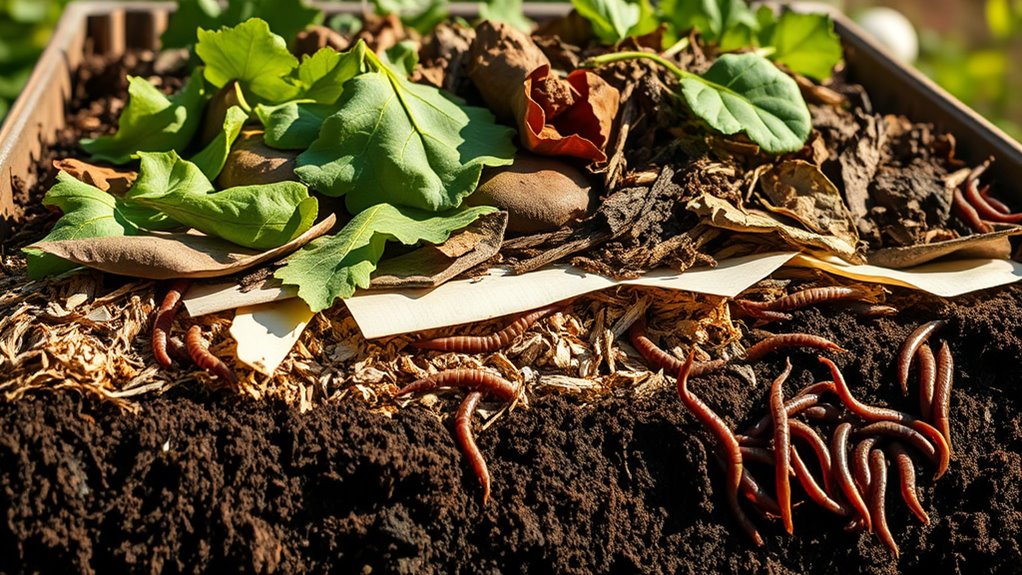Compost Like a Pro With These 5 Simple Tricks
To compost like a pro, you’ll start by choosing the right materials—think kitchen scraps and yard waste while skipping meats and oils. Next, balance your greens (like veggie peels) with browns (like leaves) in a 2-3:1 ratio for ideal decomposition. Keep the pile moist, feeling like a wrung-out sponge, to fuel microbes. Turn it every 1-2 weeks for fresh oxygen and to avoid odors. Troubleshoot by adding browns for smells or aerating slow piles—explore these tips further for your garden’s success.
Choose the Right Materials
When you’re composting, choosing the right materials sets the foundation for success.
Follow these composting tips to select items that break down effectively: use kitchen scraps like fruit peels, vegetable ends, and coffee grounds for nutrients, plus yard waste such as leaves and straw for structure. Additionally, incorporating small-space solutions can help you effectively manage composting even in limited areas. Avoid meats, dairy, oily foods, and treated wood to prevent pests and odors, ensuring a thriving, odor-free pile that yields rich soil.
Balance Greens and Browns
Balancing greens and browns is essential for a thriving compost pile.
As an expert composter, you must carefully balance nitrogen-rich greens with carbon-rich browns to optimize decomposition.
- Use greens like kitchen scraps and grass for nitrogen.
- Add browns such as dried leaves and paper for carbon.
- Aim for a 2-3:1 browns-to-greens ratio to prevent imbalances.
- Mix materials thoroughly as you build your pile for even results.
In addition, maintaining proper moisture levels is crucial to facilitate the decomposition process.
Maintain Proper Moisture
Maintaining proper moisture in your compost pile is key to efficient decomposition; you’ll need to keep it as damp as a wrung-out sponge to foster microbial activity without risking sogginess or drying out. To check, squeeze a handful—it should feel moist but not drip. Monitor these indicators for balance:
| Indicator | Action |
|---|---|
| Too dry (crumbly) | Add water |
| Ideal (damp) | Do nothing |
| Too wet (soggy) | Mix in browns |
| Slow breakdown | Adjust moisture |
| Foul odor | Add dry material |
Additionally, maintaining ideal moisture levels allows for optimal decomposition and helps prevent unpleasant odors from developing.
Turn Your Compost Regularly
Regularly turning your compost pile introduces essential oxygen, accelerating decomposition and preventing unpleasant odors.
You’ll break up materials, mix in nutrients, and maintain an even temperature for ideal results.
Here’s how to do it effectively:
- Use a pitchfork or aerator to gently mix the pile every 1-2 weeks.
- Aim for the center to outer edges to achieve uniform aeration.
- Monitor the pile’s heat; it should warm up after turning.
- Adjust frequency based on moisture and material type for efficiency.
Additionally, incorporating smart composting practices can further enhance the speed of decomposition in your pile.
Troubleshoot Common Issues
What if your compost pile starts smelling foul or decomposing slowly? As an expert, you’ll troubleshoot effectively. Foul odors mean too many greens, so add browns like leaves. Slow decomposition signals poor aeration, so turn and moisten it. Pests indicate exposed waste, so bury scraps deeper. Here’s a table for quick fixes:
| Issue | Solution |
|---|---|
| Foul Smell | Add dry materials |
| Slow Decomposition | Turn regularly and aerate |
| Pests | Cover and balance layers |
Additionally, incorporating the benefits of mulching can enhance your composting process and overall garden health. Apply these for best results.

